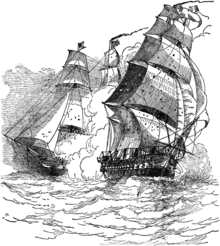USS Constellation vs La Vengeance
| USS Constellation vs La Vengeance | |||||||
|---|---|---|---|---|---|---|---|
| Part of the Quasi-War | |||||||
 USS Constellation engaging the French frigate La Vengeance | |||||||
| |||||||
| Belligerents | |||||||
|
|
| ||||||
| Commanders and leaders | |||||||
|
Thomas Truxton |
| ||||||
| Strength | |||||||
|
1 frigate 336 crew 38 guns |
1 frigate 380 crew 40 guns | ||||||
| Casualties and losses | |||||||
|
14 dead 25 wounded 1 frigate severely damaged |
28–160 dead 110 wounded 1 frigate severely damaged | ||||||
USS Constellation vs La Vengeance, or the action of 1 February 1800, was a
In 1798, an
Background
In 1800, the
By this point in the Quasi-War, the 1,265-ton Constellation carried 38 cannon despite officially being classified by the United States Navy as a 36-gun frigate. Previously her armament had consisted of 24-pounder guns, but these had proven inefficient during Truxton's
Engagement

On 1 February 1800 at 07:00, Truxton's crew spotted what appeared to be a 54-gun frigate flying British colors two leagues off the Basse-Terre
At this point the action began, with Pitot's
La Vengeance prepared for a
Aftermath

Casualties were heavy on both sides, and both vessels were in such poor condition that each commander thought he had sunk his opponent. Most of La Vengeance's rigging had been blown away; only the lower
Constellation had suffered heavy damage with 15 of her crew slain and a further 25 wounded, of whom 11 later died. The ship sailed to
but Truxton could not complete the necessary repairs because of a shortage of naval stores. The ship left Jamaica a week after she arrived, with only her mainmast replaced. After escorting a convoy of 14 merchantmen back to the United States, Truxton sailed his battered frigate to Hampton Roads for a proper refit. Only after he returned to the United States did the American commodore finally learn that the La Vengeance had not been sunk.[14] Truxton was considered a hero and received considerable praise for his actions. In response to his battle with Pitot's frigate, the American government commended Truxton with a Congressional Gold Medal depicting the battle.[15] James C. Jarvis, a 13-year-old Midshipman who was killed when the mainmast collapsed, became famous for his bravery during the battle.References
- ^ Palmer 1987, p. 183.
- ^ Palmer 1987, p. 149.
- ^ Palmer 1987, p. 184.
- ^ a b c Palmer 1987, p. 185.
- ^ a b c Palmer 1987, p. 187.
- ^ a b c d Toll 2006, p. 132.
- ^ Palmer 1987, pp. 187–188.
- ^ Hill 1903, p. 190.
- ^ Cooper 1839, p. 306.
- ^ a b Palmer 1987, p. 186.
- ^ Toll 2006, p. 133.
- ^ Palmer 1987, p. 196.
- ^ Allen 1909, p. 172.
- ^ Toll 2006, p. 134.
- ^ Shaffner 1864, p. 188.
Sources
- Allen, Gardner Weld (1909). Our naval war with France. Boston and New York: Houghton Mifflin Company. OCLC 1202325.
- OCLC 4765607.
- Hill, Frederic Stanhope (1903). Twenty-six Historic Ships. New York and London: G.P. Putnam's Sons. OCLC 2622223.
- Palmer, Michael A. (1987). Stoddert's War. Annapolis: Naval Institute Press. OCLC 15162322.
- OCLC 634744808.
- Toll, Ian W. (2006). Six Frigates: The Epic History of the Founding of the US Navy. New York: W. W. Norton. OCLC 633333009.
- Troude, Onésime-Joachim (1867). Batailles navales de la France (in French). Vol. 3. Challamel ainé. pp. 200–201.
